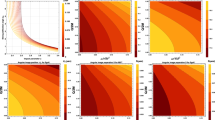Abstract
In this article, I will attempt to give an overview of the motivations for studying black holes and of the current major problems in the field. I will also give some perspectives on what can be done in the future, focusing on instrumentation which has already been approved. This chapter will necessarily be more speculative than the other chapters in this volume.
Similar content being viewed by others
Notes
On the other hand, it should also be noted that the maximum mass of a neutron star is far more sensitive to whether general relativity properly describes gravity than is anything measureable from black hole accretion disks (see e.g. Psaltis 2008).
Although it is worth noting that some reasonable attempts have been made to identify surface effects from neutron stars which are prominent enough that absence of them would be evidence of absence of a surface.
With the Rossi X-ray Timing Explorer, for many sources, including the Crab, acceptable fits in χ 2 terms can be found with relatively simple spectral models, with the systematic errors added to the data being no more than 1 %. This is suggestive of the calibration being good to about 1 %, but still runs into questions about how well the Crab spectrum is really known.
Some groups do debate whether this change happens exactly at the transition to the hard state, or at a somewhat lower fraction of the Eddington luminosity (e.g. Rykoff et al. 2007), but not whether this effect happens at all.
The improvement for the new concept Athena+ would be a factor of about 5 in effective area over XMM-Newton
References
M.A. Abramowicz, W. Kluźniak, Astronomy & Astrophysics 374, L19 (2001)
M. Ackermann, M. Ajello, A. Allafort et al., Science 338, 1190 (2012)
X. Barcons, D. Barret, A. Derouchelle et al. (2012). arXiv:1207.2745
K. Belczynski, T. Bulik, C.L. Fryer et al., Astrophysical Journal 714, 1217 (2010)
J.A. Braatz, A.S. Wilson, C. Henkel, Astrophys. J. Suppl. 110, 321 (1997)
A. Cantrell et al., Astrophys. J. 710, 1127 (2010)
P. Casella, T.J. Maccarone, K. O’Brien et al., Monthly Notices of the Royal Astronomical Society 404, L21 (2010)
T. Di Matteo, V. Springel, L. Hernquist, Nature 433, 604 (2005)
C. Done, S.W. Davis, C. Jin, O. Blaes, M. Ward, Monthly Notices of the Royal Astronomical Society 420, 1848 (2012)
R. Fender, S. Corbel, T. Tzioumis et al., Astrophysical Journal Letters 519, L165 (1999)
M. Feroci, L. Stella, M. van der Klis et al., Experimental Astronomy 34, 415 (2012)
A.V. Filippenko, L.C. Ho, Astrophysical Journal Letters 588, L13 (2003)
J. Frank, A. King, D.J. Raine, in Accretion Power in Astrophysics, ed. by J. Frank, A. King, D. Raine, p. 398 (Cambridge University Press, Cambridge, 2002). ISBN 0521620538
C.L. Fryer, K. Belczynski, G. Wiktorowicz et al., Astrophysical Journal 749, 91 (2012)
O.Y. Gnedin, T.J. Maccarone, D. Psaltis, S.E. Zepf, Astrophysical Journal Letters 705, L168 (2009)
H.-J. Grimm, M. Gilfanov, R. Sunyaev, Monthly Notices of the Royal Astronomical Society 339, 793 (2003)
W.-M. Gu, Astrophysical Journal 753, 118 (2012)
K. Gültekin, D.O. Richstone, K. Gebhardt et al., Astrophysical Journal 698, 198 (2009)
S. Heinz, R.A. Sunyaev, Monthly Notices of the Royal Astronomical Society 343, L59 (2003)
R.K. Jain, C.D. Bailyn, J.A. Orosz, J.E. McClintock, R.A. Remillard, Astrophysical Journal Letters 554, L181 (2001)
P.G. Jonker, C.G. Bassa, G. Nelemans et al., Astrophysical Journal Supplement 194, 18 (2011)
S. Justham, K. Schawinski, Monthly Notices of the Royal Astronomical Society 423, 1641 (2012)
B.C. Kelly, T. Treu, M. Malkan, A. Pancoast, J.-H. Woo (2013). arXiv:1307.5253
A. King, Astrophysical Journal Letters 596, L27 (2003)
H. Krawczynski, P.S. Coppi, T. Maccarone, F.A. Aharonian, Astronomy & Astrophysics 353, 97 (2000)
C.Y. Kuo, J.A. Braatz, J.J. Condon et al., Astrophys. J. 727, 20 (2011)
J.E. McClintock, R.A. Remillard, Compact Stellar X-ray Sources (2006), p. 157
I.M. McHardy, E. Koerding, C. Knigge, P. Uttley, R.P. Fender, Nature 444, 730 (2006)
J.M. Miller, J. Homan, Astrophysical Journal Letters 618, L107 (2005)
I.F. Mirabel, L.F. Rodríguez, Nature 371, 46 (1994)
I.F. Mirabel, M. Dijkstra, P. Laurent, A. Loeb, J.R. Pritchard, Astronomy & Astrophysics 528, A149 (2011)
B.M. Peterson, L. Ferrarese, K.M. Gilbert et al., Astrophysical Journal 613, 682 (2004)
E.S. Phinney, Monthly Notices of the Royal Astronomical Society 198, 1109 (1982)
P. Psaltis, Astrophys. J. 688, 1282 (2008)
C.S. Reynolds, L.W. Brenneman, A.M. Lohfink et al., Astrophys. J. 755, 88 (2012)
L. Rezzolla, S. Yoshida, T.J. Maccarone, O. Zanotti, Monthly Notices of the Royal Astronomical Society 344, L37 (2003)
E.S. Rykoff, J.M. Miller, D. Steeghs, M.A.P. Torres, Astrophysical Journal 666, 1129 (2007)
B.F. Schutz, Classical and Quantum Gravity 16, A131 (1999)
A. Soltan, Monthly Notices of the Royal Astronomical Society 200, 115 (1982)
J.F. Steiner, R.C. Reis, A.C. Fabian et al., Monthly Notices of the Royal Astronomical Society 427, 2552 (2012)
T.E. Strohmayer, Astrophysical Journal Letters 554, L169 (2001)
M. Symeonidis, A. Georgakakis, N. Seymour et al., Monthly Notices of the Royal Astronomical Society 417, 2239 (2011)
H. Tananbaum, H. Gursky, E. Kellogg, R. Giacconi, C. Jones, Astrophysical Journal Letters 177, L5 (1972)
P. Ubertini, N. Gehrels, A Space Astronomy Global Road Map for the Next Decades, in 3th COSPAR Scientific Assmebly, vol. 39 (2012)
M. van der Klis, Astrophysical Journal Supplement 92, 511 (1994)
R.C.E. van den Bosch, K. Gebhardt, K. Gültekin et al., Nature 491, 729 (2012)
A. Veledina, J. Poutanen, I. Vurm (2012). arXiv:1210.0236 [astro-pH.HE]
D. Watson, K.D. Denney, M. Vestergaard, T.M. Davis, Astrophysical Journal Letters 740, L49 (2011)
Acknowledgements
I wish to thank the organizers and the participants of the workshop for an interesting program.
Author information
Authors and Affiliations
Corresponding author
Rights and permissions
About this article
Cite this article
Maccarone, T.J. Black Hole Studies: Overview and Outlook. Space Sci Rev 183, 477–489 (2014). https://doi.org/10.1007/s11214-013-0026-2
Received:
Accepted:
Published:
Issue Date:
DOI: https://doi.org/10.1007/s11214-013-0026-2




